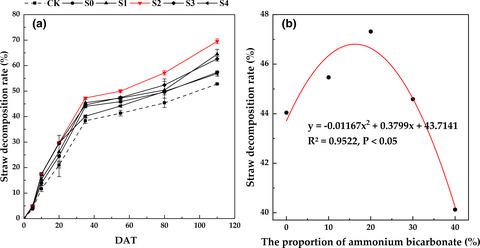当前位置:
X-MOL 学术
›
Food Energy Secur.
›
论文详情
Our official English website, www.x-mol.net, welcomes your
feedback! (Note: you will need to create a separate account there.)
The combination of different nitrogen fertilizer types could promote rice growth by alleviating the inhibition of straw decomposition
Food and Energy Security ( IF 4.0 ) Pub Date : 2021-06-04 , DOI: 10.1002/fes3.298 Jichao Tang 1, 2 , Ruoyu Zhang 1 , Hechao Li 1 , Jiali Tan 1 , Wenjie Song 1 , Xin Wen 1 , Bilin Lu 1, 2, 3 , Zhengrong Hu 4
Food and Energy Security ( IF 4.0 ) Pub Date : 2021-06-04 , DOI: 10.1002/fes3.298 Jichao Tang 1, 2 , Ruoyu Zhang 1 , Hechao Li 1 , Jiali Tan 1 , Wenjie Song 1 , Xin Wen 1 , Bilin Lu 1, 2, 3 , Zhengrong Hu 4
Affiliation

|
Straw return plays an important role in the improvement of farmland ecological environments, increasing soil fertility, crop quality, and yield. However, in the early growth of rice (Oryza sativa L.), straw decomposition and rice growth may be inhibited by suboptimal carbon/nitrogen (C/N) ratios. We, therefore, explored methods that could alleviate the inhibition of straw decomposition using different combinations of ammonium bicarbonate and compound fertilizer. No fertilizer (CK) and compound fertilizer (S0) were used as the control. The ratios of added ammonium bicarbonate were 10% (S1), 20% (S2), 30% (S3), and 40% (S4), respectively. Compared with the S0 treatment, the S2 treatment accelerated straw decomposition, promoted the early growth of tillers and roots, and improved the leaf area index, dry matter accumulation, and N use efficiency (apparent N utilization, agronomic N utilization, and partial factor productivity increased by 4.05‒19.48% in two years). Moreover, panicle number, filled-grain percentage, and 1000-grain weight were significantly higher in the S2 treatment than other treatments. The grain yield of S2 treatment was significantly higher than that of S0 treatment by 4.06% (2019) and 5.66% (2020). Regression analysis revealed that the optimal ratios of ammonium bicarbonate for increasing straw decomposition and grain yield were relatively close, 16.27% and 14.60%, respectively. These results suggest that compared with conventional fertilization method (S0), the 20% treatment is a more effective fertilization method that prevents inhibition of straw decomposition, promoting rice growth and yield, and improving nitrogen (N) use efficiency.
中文翻译:

不同氮肥类型组合可通过缓解秸秆分解抑制促进水稻生长
秸秆还田对改善农田生态环境、提高土壤肥力、作物品质和产量具有重要作用。然而,在水稻(Oryza sativaL.),秸秆分解和水稻生长可能会受到次优碳/氮 (C/N) 比的抑制。因此,我们探索了使用碳酸氢铵和复合肥的不同组合来减轻秸秆分解抑制的方法。不施肥(CK)和复合肥(S0)作为对照。碳酸氢铵的添加比例分别为10%(S1)、20%(S2)、30%(S3)和40%(S4)。与S0处理相比,S2处理加快了秸秆分解,促进了分蘖和根系的早期生长,提高了叶面积指数、干物质积累量和氮素利用效率(表观氮素利用率、农艺氮素利用率和部分要素生产率)两年增长 4.05-19.48%)。此外,穗数、满粒率、S2处理的千粒重和千粒重显着高于其他处理。S2处理的籽粒产量显着高于S0处理4.06%(2019年)和5.66%(2020年)。回归分析表明,提高秸秆分解率和粮食产量的最佳碳酸氢铵配比比较接近,分别为16.27%和14.60%。这些结果表明,与常规施肥方法(S0)相比,20%处理是一种更有效的施肥方法,可以防止抑制秸秆分解,促进水稻生长和产量,提高氮(N)的利用效率。回归分析表明,提高秸秆分解率和粮食产量的最佳碳酸氢铵配比比较接近,分别为16.27%和14.60%。这些结果表明,与常规施肥方法(S0)相比,20%处理是一种更有效的施肥方法,可以防止抑制秸秆分解,促进水稻生长和产量,提高氮(N)的利用效率。回归分析表明,提高秸秆分解率和粮食产量的最佳碳酸氢铵配比比较接近,分别为16.27%和14.60%。这些结果表明,与常规施肥方法(S0)相比,20%处理是一种更有效的施肥方法,可以防止抑制秸秆分解,促进水稻生长和产量,提高氮(N)的利用效率。
更新日期:2021-06-04
中文翻译:

不同氮肥类型组合可通过缓解秸秆分解抑制促进水稻生长
秸秆还田对改善农田生态环境、提高土壤肥力、作物品质和产量具有重要作用。然而,在水稻(Oryza sativaL.),秸秆分解和水稻生长可能会受到次优碳/氮 (C/N) 比的抑制。因此,我们探索了使用碳酸氢铵和复合肥的不同组合来减轻秸秆分解抑制的方法。不施肥(CK)和复合肥(S0)作为对照。碳酸氢铵的添加比例分别为10%(S1)、20%(S2)、30%(S3)和40%(S4)。与S0处理相比,S2处理加快了秸秆分解,促进了分蘖和根系的早期生长,提高了叶面积指数、干物质积累量和氮素利用效率(表观氮素利用率、农艺氮素利用率和部分要素生产率)两年增长 4.05-19.48%)。此外,穗数、满粒率、S2处理的千粒重和千粒重显着高于其他处理。S2处理的籽粒产量显着高于S0处理4.06%(2019年)和5.66%(2020年)。回归分析表明,提高秸秆分解率和粮食产量的最佳碳酸氢铵配比比较接近,分别为16.27%和14.60%。这些结果表明,与常规施肥方法(S0)相比,20%处理是一种更有效的施肥方法,可以防止抑制秸秆分解,促进水稻生长和产量,提高氮(N)的利用效率。回归分析表明,提高秸秆分解率和粮食产量的最佳碳酸氢铵配比比较接近,分别为16.27%和14.60%。这些结果表明,与常规施肥方法(S0)相比,20%处理是一种更有效的施肥方法,可以防止抑制秸秆分解,促进水稻生长和产量,提高氮(N)的利用效率。回归分析表明,提高秸秆分解率和粮食产量的最佳碳酸氢铵配比比较接近,分别为16.27%和14.60%。这些结果表明,与常规施肥方法(S0)相比,20%处理是一种更有效的施肥方法,可以防止抑制秸秆分解,促进水稻生长和产量,提高氮(N)的利用效率。











































 京公网安备 11010802027423号
京公网安备 11010802027423号